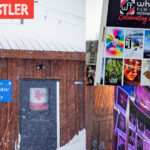Pro ski photographer TOM WEAGER has the skinny on drones.
The art of visually capturing the best of our sport has a long and entertaining history. When personal-use drones and their cameras first started buzzing above our heads, the connection with skiing seemed obvious. Today, with so much choice available of what to put in your backpack, the research on what’s best for you can be overwhelming. Here are seven things to consider when you’re cruising DJI’s website and beyond—as well as some help on taking better pics and vids.

SIZE MATTERS
Smaller doesn’t necessarily mean less, which is good news for skiers. Whether you’re in the backcountry or on and off the chairlift repeatedly, you’ll be aware of how much space is taken up in your pack. Drones under 250g are packable, lightweight, nimble and not confined to the same regulations under Transport Canada that drones over 250g are. Though you’ll compensate slightly with a shorter battery life and lesser image quality, a more compact size means more freedom and less worry about where you can and can’t legally fly.
BATTERY LIFE
Battery technology continues to advance, with some models of drones claiming close to a one-hour flight time. Keep in mind that flight time is difficult to calculate given major influences such as the number of photos or amount of video you shoot, your flight speed and battery-reducing weather conditions, including wind and cold temps. Many models come with the option of additional batteries. If you plan on flying often and in remote places with limited charging, then this is a worthwhile investment.
CAMERA
High-end consumer drones all come with cameras, or the ability to mount your own. The resolution and quality of these built-in cameras has come leaps and bounds since commercial drones became more commonplace. Video shot in 4K and 60FPS is becoming standard, with adjustable aperture and telephoto lenses right around the corner. Search online for comparison videos and pictures to see for yourself the differences.
INTELLIGENCE
AI in drones is advancing. If your buddies are skiing a line and you want to film them, make sure your drone has obstacle avoidance. That way you can worry about getting the shot and little else. With the correct settings enabled, it’s now virtually impossible to crash modern high-end drones. Even if you get very low on battery life, the automatic “return to home” feature is common on nearly all models. When you’re launching or landing your drone in deep snow, first set up a portable landing pad or use the hand-release method.
RANGE

Want the ability to explore and show scale? The farther you can fly, the better you can showcase your experience. Direct line-of-sight range can be more than 10 km, which is a huge distance. As soon as you start including obstacles this can be drastically reduced, so be aware when flying around the corner of that next cliff.
FPV AND CONTROLLERS
First-person-viewing has arrived. Pioneered by drone racers, this technology has now landed in the commercial market with some mainstream high-end models allowing it as an optional method for exhilarating flying. The FPV goggles slip on over your eyes and you can now be fully immersed and at one with your drone. As standard, most models come with a hand-held controller with a digital display or it will plug into your phone and use an app.
BE CAREFUL WHERE YOU FLY
Transport Canada has strict regulations regarding drone usage, and if your drone weighs more than 250g you must register it and take a drone licence exam. Be aware that most ski resorts do not allow the use of drones on their tenure, so make sure you check before flying inbounds. As well, flying a drone is forbidden in national parks and within prescribed distances to airports. Fortunately, a lot of high-end drones now come with mapped data informing you where you can and can’t fly.
BEFORE TAKEOFF_
The Mavic series by industry leader DJI has 10 models with a weight, price and lengthy list of features that fit a skier’s wish list. Its newly released Mavic 3 includes a 4/3 CMOS Hasselblad camera.

TIPS FOR BETTER PICS
• Looking directly down on your subjects from above is the most fun and innovative way to shoot with drones. It helps give a whole new perspective on the world.
• Move! If you’re filming, try not to keep your drone stationary. Have a skier cruise down a slope as you pan across, or try zooming out to bring the whole scene to life. If you want to give a sense of speed, follow your subject from behind.
• Shoot from a distance to give a sense of scale. Having a backdrop of mountain ranges, trees or clouds helps the viewer understand the scene better.
• Make sure you don’t over-expose the snow on bright days. A lot of high-end drones come with ND (neutral density) filters. These filters can be used to reduce brightness, and add contrast and a cinematic look to your footage.
• When filming, try to pan by moving the drone in the air instead of turning the camera head, since this can create screen-tearing and blurry footage, and is generally disorienting. Panning will create a smoother visual experience.
• Practice using manual shooting mode. Automatic shutter speed, ISO and White Balance are great assets, but if you really want full control over your footage, you have to take the plunge and do it yourself.
from Dec/Jan 2022 issue



